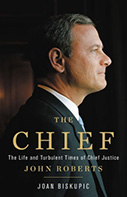The Chief: The Life And Turbulent Times Of Chief Justice John Roberts

Author: Joan Biskupic
Publisher: New York: Basic Books, 2019. 432p.
Reviewer: Jack E. Call | July 2019
In 2018, Justice Anthony Kennedy retired from the United States Supreme Court and was replaced by Brett Kavanaugh. In most 5-4 decisions from the Court after Justice Sandra Day O’Connor retired in 2006, Justice Kennedy was the “swing vote,” determining whether the case resulted in a liberal or conservative outcome. Thus, an important question for observers of the Court (and the public) after Kennedy’s retirement is, who will be the new swing vote. Many commentators believe that it is likely to be Chief Justice John Roberts.
Joan Biskupic’s new biography of Roberts provides a great deal of material relevant to the question of whether Roberts is likely to be the new swing Justice. Biskupic is a long-time, well-respected observer of the Court whose extensive sources of information for this book included interviews with a majority of the Supreme Court Justices (as well as Roberts himself).
An issue of great public importance that receives considerable attention in THE CHIEF concerns race. As Chief Justice in 2007, Roberts wrote an important opinion holding that it is unconstitutional to take race into account in deciding where to assign students to schools (Meredith v. Jefferson County Board of Education and Parents Involved in Community Schools v. Seattle School District No.1). In doing so, he rejected the value of diversity in schools.
He also wrote the majority opinion in a voting rights case that involved race, Shelby County v. Holder. The Court struck down the formula established by Congress to determine when states have to seek preclearance from the Department of Justice before adopting significant changes in its voting laws (to insure that the changes were not racially motivated).
Roberts also took minority positions in a 5-4 decision striking down a Texas re-districting map because it unconstitutionally diluted the votes of Mexican Americans and in another case upholding the University of Texas’ consideration of race in admissions decisions. These positions demonstrate a hostility to governmental considerations of race in its policy-making.
This hostility was evident early in Roberts’ career. As a lawyer in the Reagan Administration, he wrote a memorandum to his boss in which he adopted the position of Justice Rehnquist (for whom Roberts had clerked) that racial quotas are “a creator of castes, a two-edged sword that must demean one in order to prefer another.”
A later incident in his governmental work (prior to his judicial appointments) further illustrates the depth of Roberts’ opposition to any consideration of race in governmental decisions. It occurred when he was Deputy Solicitor General in the Bush 41 Administration. The incident involved a case (Metro Broadcasting, Inc. v. Federal Communications Commission) dealing with the awarding of a television channel by the Federal Communications Commission to a predominantly Hispanic-owned company. The FCC had a policy of considering race in its licensing decisions as part of a goal of increasing diversity in ownership. The previous year, the Supreme Court had decided another case (Richmond v. Croson) that prohibited the consideration of race in awarding public contracts at the municipal level.
While Croson was certainly a relevant precedent, it was not directly on point, and the FCC was determined to pursue its goal of diversity. Ordinarily, the Solicitor General’s office supports the legal position taken by federal agencies. However, in this case, Roberts chose to rely on the Croson case to argue that the FCC policy was unconstitutional, in spite of a specific request from the FCC that the SG support its position.
According to Biskupic, Roberts’ decision was troubling to the career lawyers in the SG’s office. (Only the Solicitor General and Deputy SG are political appointees. The rest of the lawyers in the office are career lawyers who typically remain in office, even with a change in Presidents). In light of these circumstances, it is apparent that Roberts was more committed to his personal view of the proper approach to race under the Equal Protection Clause than he was to institutional traditions.
Biskupic concludes that Roberts has “remained steadfast in his view that claims of discrimination must be made by individuals in specific circumstances and not by groups. He was convinced that racial policies had backfired. Roberts has not deviated from that belief from the 1980s to the present day.” (p.273)
In another area of great public concern, abortion cases, Roberts has also been conservative in his positions. In Whole Women’s Health v. Hellerstedt, he took the minority position that a Texas law requiring all doctors performing abortions to have admitting privileges at a local hospital did not place an unconstitutional burden on the right to an abortion. This antipathy to a right to abortion was also apparent during Roberts’ tenure as Deputy Solicitor General, where he argued in a case that abortion protesters who attempted to prevent women from entering abortion clinics did not violate federal law. In addition, he formally took the position that Roe v. Wade should be overturned in Rust v. Sullivan, a case involving a Reagan Administration regulation that prohibited clinics receiving federal funds from providing abortion counseling to its patients.
While these cases (and many others discussed in THE CHIEF) demonstrate Roberts’ strongly held conservative views, he has also demonstrated that on occasion those views are outweighed by his concern for how the public will react to decisions made by the Court.
For example, in an Affordable Care Act case in 2012 (National Federation for Independent Business v. Sibelius), Roberts initially was ready to uphold the provision mandating Medicaid expansion for states, but wanted to strike down the individual mandate that requires everyone to obtain health insurance or pay a penalty. During oral argument, Roberts seemed skeptical about the government’s secondary argument that the mandate could be viewed as a tax (as he eventually decided). Eventually, Roberts switched his positions on both the individual mandate and Medicaid expansion. Biskupic suggests that Roberts’ switch stemmed from a fear that striking down the individual mandate would result in an insurance crisis for which the public would blame the Court. It is this apparent willingness to adjust his positions out of a concern for public perception of the Court that makes Roberts more likely than other conservative Justices to become the swing Justice.
On the other hand, Roberts occasionally has demonstrated his conservative leanings in a way that he must have recognized the public would perceive as controversial (perhaps even to the detriment of the public’s perception of the Court). The primary example of this is his dissent in Obergefell v. Hodges, where the Court held that the Due Process and Equal Protection Clauses prohibit states from banning same sex marriages. Roberts was well aware that Justice Scalia had used strident language about gay rights in some of his opinions, and Roberts believed that such language damaged the Court’s public image. Although he attempted to be more restrained in the language he used in his dissent, he nevertheless read his dissent in Obergefell from the bench and compared the majority’s decision to the infamous Dred Scott Case.
One of the disappointments of THE CHIEF for students of the criminal justice system is that the book gives very little attention to criminal justice opinions of the Roberts Court. (THE CHIEF devotes less than a page to two extremely important criminal cases, United States v. Wurie and Riley v. California, holding that the police need a warrant to search the contents of cell phones found during a search incident to arrest). A very noticeable oversight is that no attention is given to a controversial exclusionary rule case, Herring v. United States. In Herring, the Court declined to apply the exclusionary rule to evidence obtained from a search conducted incident to an illegal arrest. The arrest was based on a computer entry indicating that an arrest warrant was outstanding for the defendant. However, the arrest was illegal because the warrant had been withdrawn, but the warrant entry had not been removed from the computer database. In spite of the fact that it was the police who were responsible for the failure to remove the database entry, the Court determined that excluding this evidence would not have a sufficient deterrent effect on police misconduct to outweigh the cost to the public of disallowing use of the incriminating evidence.
In its discussion of the basis for this ruling, Roberts, writing for the Court, indicated that “the exclusionary rule serves to deter deliberate, reckless, or grossly negligent conduct, or in some circumstances recurring or systemic negligence. The error in this case does not rise to that level.” This language suggests that the exclusionary rule does not apply when the police obtain evidence in situations where an officer honestly and reasonably thought that she was not violating the Constitution. However, the Court has never explicitly issued a ruling to that effect.
It is quite possible that Roberts’ language in Herring is designed to lay the groundwork for the Court’s adoption of what can be called a full-blown good faith exception to the exclusionary rule. The Court has established some limited good faith exceptions to the exclusionary rule, but it has never explicitly ruled that the exclusionary rule does not apply in all instances where the police honestly and reasonably violate the Constitution.
Biskupic’s failure to include a discussion of Herring is all the more noteworthy because she suggests that a similar strategy may have been used by Roberts in racial discrimination cases. She indicates that in Northwest Austin Municipal Utility District No. 1 v. Holder, Roberts set the stage for the Court’s adoption of an “equal sovereignty” doctrine, i.e., that Congress must (under the 14th Amendment to the Constitution) treat all the states in the same way. This equal sovereignty doctrine had been rejected by the Court nearly forty years earlier in South Carolina v. Katzenbach. Nevertheless, Roberts used the doctrine as the basis for his majority opinion in Shelby County v. Holder, striking down the formula used to determine which states have to obtain Department of Justice approval for changes in its voting laws.
In closing, Biskupic suggests that there are some hints that Roberts is not universally loved in other chambers. She indicates, for example, that some Court personnel have referred to Roberts as “King John.” In her epilogue, Biskupic says that “some associates do not trust Roberts and think his diffidence is strategic, that he is not always acting in good faith, that he is not an honest broker.” (p. 347) In spite of this, few observers of the Court will take issue with Biskupic’s conclusion that “[Roberts] is positioned in the center in every way, and the law will likely be what he says it is.” (p. 349)
References:
Herring v. United States, 555 U.S. 135 (2009).
Meredith v. Jefferson County Board of Education, 551 U.S. 701 (2007).
Metro Broadcasting, Inc. v. Federal Communications Commission, 497 U.S. 547 (1990).
National Federation for Independent Business v. Sebelius, 497 U.S. 547 (2012).
Northwest Austin Municipal Utility District No. 1 v. Holder, 557 U.S. 193 (2009).
Obergefell v. Hodges, 576 U.S. ____ (2015).
Parents Involved in Community Schools v. Seattle School District No.1, 551 U.S. 701 (2007).
Richmond v. Croson, 488 U.S. 469 (1989).
Riley v. California, 573 U.S. 373 (2014).
Rust v. Sullivan, 500 U.S. 173 (1991).
Shelby County v. Holder, 570 U.S. 529 (2013).
South Carolina v. Katzenbach, 383 U.S. 301 (1966).
United States v. Wurie, 573 U.S. 373 (2014).
Whole Women’s Health v. Hellerstedt, 579 U.S. ____ (2016).
Jack E. Call, Professor of Criminal Justice, Radford University.


